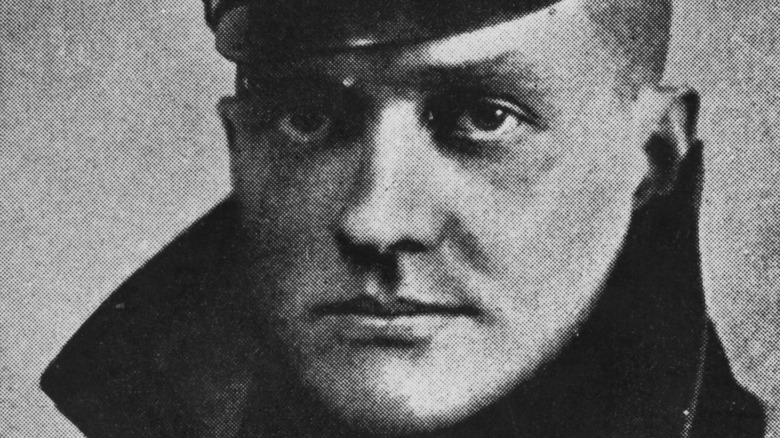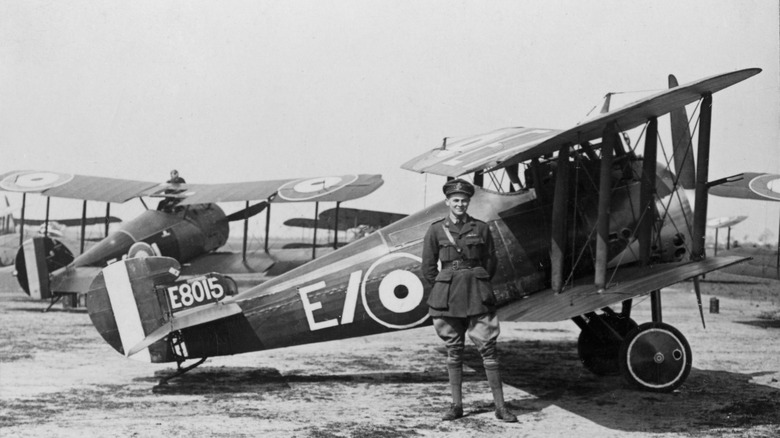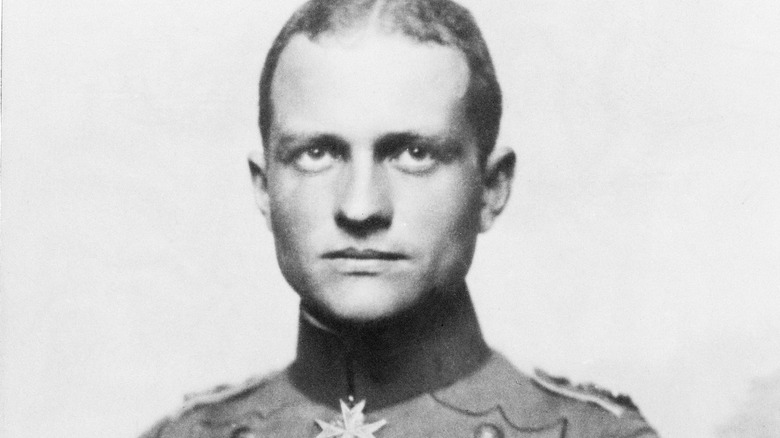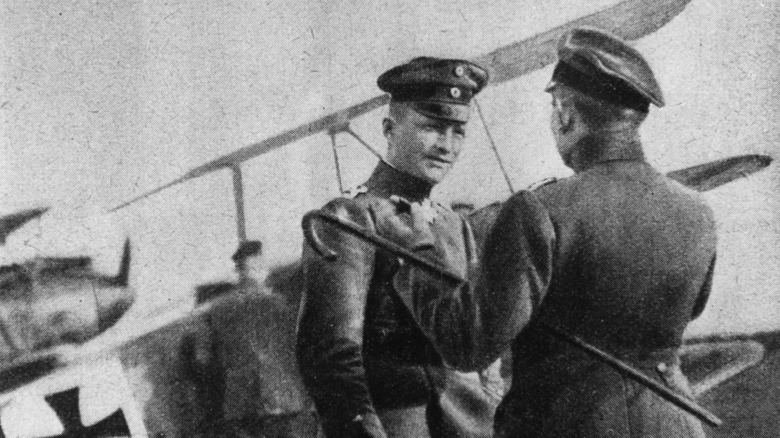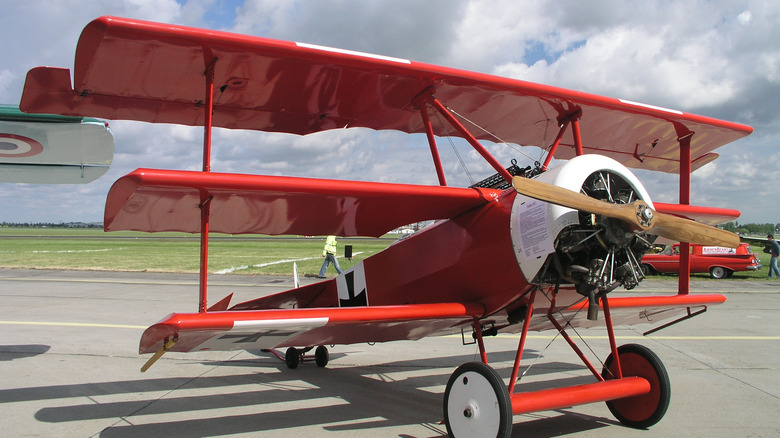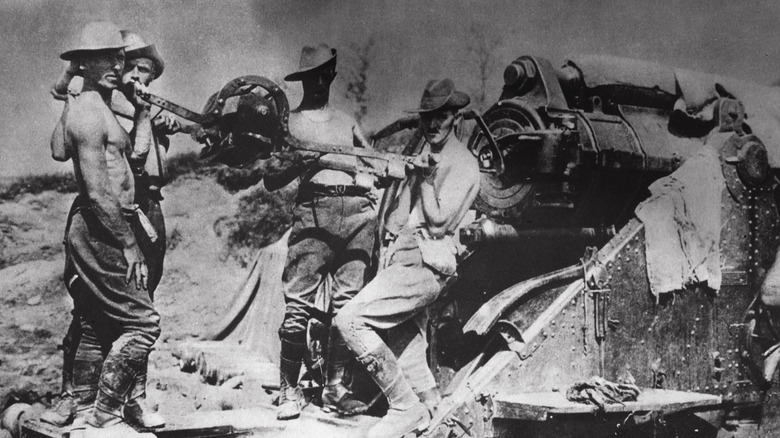The Person Who Shot Down The Famed Red Baron Remains A Mystery
World War I was an unusual war in the sense that it came at a time when technology was in the process of completely changing warfare, but vestiges of the old way of combat were still very visible. For instance, most sides started the war with cavalry units and were intent on using them the way they had been for centuries, even though the advent of trench warfare made this a little bit more complicated (via National Army Museum).
Another major change was that the skies became a battlefield for the first time in human history. According to History, planes were first used for reconnaissance and provided a bird's eye view of the enemy's movements. Of course, unsurprisingly, given mankind's track record, it wasn't long before planes were strapped with weaponry. New fangled flying machines had the potential to be deadly once loaded up with ammunition, and no pilot could claim more kills than Manfred von Richthofen, better known as the Red Baron.
Despite the Red Baron's status as the most feared pilot in the skies during the war, he was shot down in April 1918, and while sending the German ace plummeting to Earth in a fiery blaze would've been a major accomplishment, who should get the credit has remained up for debate.
Pilots were a new kind of hero in World War I
Just as planes were a new piece of equipment seen on battlefields in World War I, so were the men tasked with flying them. According to Tom Lamb, a specialist from Bonhams, a worldwide auction house, World War I pilots added a romantic flair to what was an otherwise gritty, ugly war.
"For the people on the ground, they were the knights in shining armor, fighting their dogfights in the air," Lamb told CNN. The pilots became well known in their home countries, with names like Rene Fonck, Billy Bishop, Eddie Mannock, and Eddie Rickenbacker becoming the best-known pilots from France, Canada, Britain, and the United States, respectively. On the other side of the equation was Germany's best-known pilot, who was, of course, Manfred von Richthofen, the Red Baron.
That prestige came at a price. According to Smithsonian Magazine, pilots didn't only face danger in dogfights — they were more likely to be killed in training or non-combat-related accidents.
Manfred von Richthofen came from a well-off family
Manfred Albrecht Freiherr von Richthofen was born in 1892 in the Breslau. He came from an aristocratic family, and his father was Major Albrecht Philipp Karl Julius Freiherr. Richthofen's early education saw him attending military schools, and he quickly asserted himself as a talented athlete and a solid horseman. According to Kentucky University Medical Center, Richthofen was assigned to the First Regiment of the Uhlans Kaiser Alexander III in 1911, but just a few years later, Germany was entrenched — literally — in World War I. At first, Richthofen used his horsemanship abilities to serve as a cavalry officer, but in 1915, a new opportunity came up for him.
According to Britannica, as it became more and more apparent that cavalry wasn't going to offer much in a conflict where trench warfare became so prevalent, Richthofen was transferred to the Imperial German Army Air Service of Luftstreitkräfte. Richthofen started as an aerial observer midway through 1915 and was involved with missions in Russia along the war's Eastern Front, per History. He was then transferred to the Western Front, and it was there that he obtained his pilot's license and flew missions on both fronts. Richthofen came into his own as a pilot when he started learning from German ace Oswald Boelcke as part of his fighter squadron known as Jasta 2.
The Red Baron racks up kills
Manfred Albrecht Freiherr von Richthofen learned the finer points of aerial combat from Oswald Boelcke and quickly perfected it. One of his most used tactics involved approaching an enemy aircraft from above with the blazing sun behind him for cover. He and his fellow Germans also attacked in groups of around four to six planes. By the start of 1917, Richthofen had amassed 16 confirmed kills and earned top military honors. He was named commander of his own squadron, Jasta 11 (via Kentucky University Medical School)
Richthofen's squadron used Albatros bi-planes (though he later became synonymous with a different plane), and he decided that he wanted them painted red, making the members of Jasta 11 instantly recognizable. The word "Freiherr" — in Manfred Albrecht Freiherr von Richthofen — roughly translates to "baron" in English. These two factors led to Richthofen's increasingly feared nickname, the Red Baron. Eventually, Jasta 11 combined with three other squadrons to form Jagdgeschwader I but were known to in the press as Richthofen's Flying Circus, per History.
The Red Baron gets shot down
As his kills continued to stack up, the Red Baron got a new ride, which was easily his most famous. It was a Fokker Dr.1 triplane. The Fokker was known for its triple-wing design, and when paired with the Baron's signature red paint scheme, it was an intimidating aircraft. While the Red Baron was known for his substantial kill count, he wasn't bulletproof himself. According to History, he sustained a skull fracture in early July 1917 from a bullet that came courtesy of a British plane during a dog fight. He then suffered headaches when he returned to the sky, and it's believed that he may have also dealt with post-traumatic stress disorder.
On April 21, 1918, the Red Baron and his Flying Circus were in a battle with British planes over France. The Red Baron was in the midst of chasing another pilot when he came under machine-gun fire from Australian gunners and bursts from ace pilot Arthur Roy Brown, who was a Canadian flying for the British Royal Air Force (via Britannica). One of the bullets in the barrage tore through the Red Baron's midsection, and he died after crash-landing in the French countryside. While Brown was credited with down the then 25-year-old pilot who amassed 80 confirmed kills, some have called into question whether or not Brown actually fired the shot that killed the Red Baron.
Who killed the Red Baron?
According to History, while Arthur Roy Brown was credited with down the then 25-year-old pilot who amassed 80 confirmed kills, some have called into question whether or not Brown actually fired the shot that killed the Red Baron, who was easily one of the most prized kills of the entire war. According to CNN, Australian intelligence officer Donald Fraser claimed that the true credit should've been given to his countryman, anti-aircraft gunner Sgt. Cedric Popkin.
Fraser provided an eyewitness account of the incident and was allegedly there to pull the dead Red Baron out of the cockpit of his wrecked plane. Fraser then rummaged through the Baron's belongings and found papers that, when shown to someone who spoke German, confirmed that the pilot really was Manfred von Richthofen. He went on to investigate which gunner was responsible for shooting down the Baron's Fokker triplane, and he concluded that it was Sgt. Popkin. This was because Fraser said he was not aware of any other gunners firing at the downed plane at the time. While Fraser did acknowledge that another battery of machine gunners was also shooting at the plane at the time, it was his opinion that it was a shot from Sgt. Popkin that brought World War I's most feared pilot to his doom.
